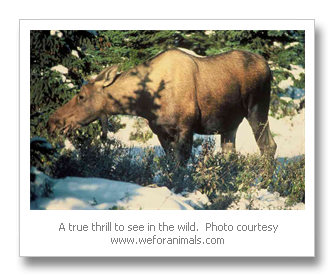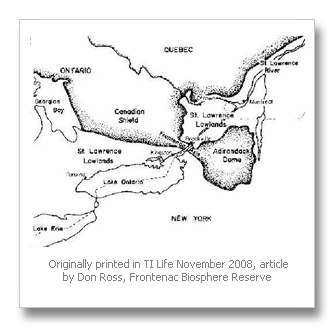Written by
James Rappaport posted on December 12, 2009 22:29
James Rappaport is a regular contributor to TI Life. In September 2009, James recognized Island Minks in New Neighbors. This month he looks at a far larger creature, but one that is rarely seen in our Thousand Islands.

The Adirondacks and Vermont have made a virtual industry out of this mysterious animal. My first encounter with one was on an early morning drive en route to a fly fishing expedition in Vermont near Montpelier. In the midst of the 4:30 AM darkness, crossing the road was a cow and her calf. A very strange animal, with a body high off the ground. A true thrill to see in the wild, but throughout the morning I was thinking about our region and the moose (or lack thereof). Given our close proximity to both regions, it seems strange why they have remained so elusive. Growing up in southern New England, we would see occasionally see newscasts with reports of wandering moose in some strange areas, including New Britain and Hartford. If they could wander that far out of their normal territory, it would seem that our region would much easier to travel to (and a much shorter excursion…).

The Thousand Islands has a terrain that would, in most aspects, be very appealing to this creature. The northern climate is a given, however there is also a great deal of marshland that sits in many of the tributaries and ponds created through the hard work of the beaver. There is also plenty of vegetation that sits within this marshland, the ideal meal for the moose.
This writer asked one of his trusted college friends who spent many years in Vermont (an avid outdoorsman, fisherman, and hunter). Apparently, the major barrier to a large moose population seems to be within the greater terrain leading to the 1000 Islands from the Adirondacks. Moose are attracted to mature forests in addition to the aforementioned habitat. The St. Lawrence River Valley is primarily flat, open terrain (with many fenced farms as well). Additionally, the moose are typically drawn towards hillier terrain (although this is apparently less important). Essentially, if there was an uninterrupted track of wooded land between the two regions, we would probably see more of them.
Given that there is evidence that moose have wandered far away from these normal Northern regions, I asked, what could convince a moose to leave the Adirondacks and come to the Thousand Islands? There are several variables, but a major one is quite encouraging. It seems that mere population growth could very well lead to the arrival. The Adirondack region has experienced an explosion of the moose population in recent years (estimated between 300-500 now). Additionally, there has been documented evidence of the moose arriving into the Adirondack Park through Canada, which would mean either a swim across the St. Lawrence (or Lake Champlain) or traveling through the flat farmland in the northern rooftop of New York (in the area between Malone and Champlain).
Addtionally there is recent evidence of a moose going through the Thousand Islands to Canada, and this has been documented.
Susie Wood, long time summer resident in Chippewa Bay and who now lives year round and works for the Thousand Islands Land Trust, substantiated the spotting, when a moose named “Alice” wandered from the Long Lake and Sabattis region of the Adirondacks into the Chippewa Bay area in 2001. Prints were found, not only on the nearby islands, but also on a new clay tennis court. Because Alice was a “transplanted” moose (originally from Western NY), she had a transmitter implanted to track her travels. She wound up swimming across the St. Lawrence, and eventually crossing the Macdonald-Cartier Freeway (Hwy 401) and the VIA rail train tracks going north into Algonquin Park. It is there where she died, but the travels of this moose makes us more optimistic to see more of these creatures locally.
Like so many inhabitants of the northern regions, the moose is one that when spotted, is a sight to behold. While the future of this large animal is not known in the Thousand Islands, we can only hope that the evidence suggests that the likelihood of more sightings will be possible. Like black bear, the moose is a wanderer and this region has plenty of room to roam.
By James Rappaport, Indian Point
James Rappaport is a strategic management consultant for publishing, radio, and cable television ventures as well as contributing writer for several media outlets. He is a summer resident of Indian Point in the Town of Hammond and lives in Connecticut in the winter.
To learn more about Alice the Moose, visit these two websites. The Spruce Moose: A publication of the Adirondack Ecological Center Newcomb Campus Fall/Winter 2001 or An incredible journey, Dennis Aprill, PressRepublican.com :